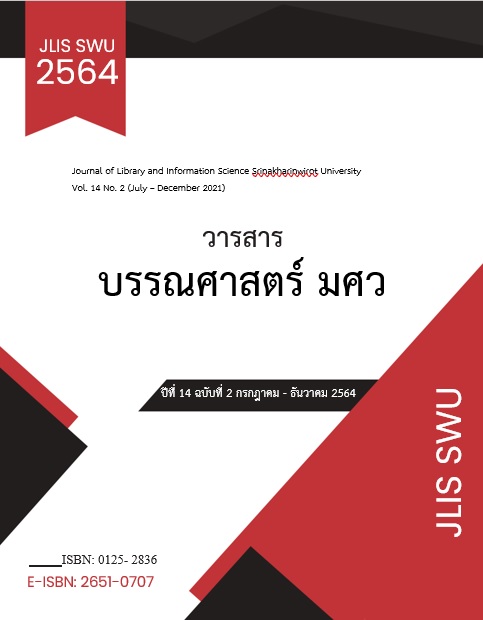การเปรียบเทียบการเซ็นเซอร์คำหยาบแบบบลีฟเซ็นเซอร์และแบบโพรฟานิตี้เซ็นเซอร์ ในรายการโทรทัศน์ออนไลน์
คำสำคัญ:
บลีฟเซ็นเซอร์ โพรฟานิตี้เซ็นเซอร์ คำหยาบ รายการโทรทัศน์ออนไลน์บทคัดย่อ
งานวิจัยครั้งนี้มีวัตถุประสงค์เพื่อเปรียบเทียบการเซ็นเซอร์แบบบลีฟเซ็นเซอร์ และแบบโพรฟานิตี้เซ็นเซอร์ ในรายการโทรทัศน์ออนไลน์ที่ส่งผลต่อความรำคาญของผู้ชม กลุ่มตัวอย่างที่ใช้ในการวิจัย ได้แก่ นักศึกษาระดับปริญญาตรี มหาวิทยาลัยเทคโนโลยีราชมงคลธัญบุรี ปีการศึกษา 2562 จำนวน 100 คน ด้วยการคำนวณจากสูตร ทาโร่ ยามาเน่ และใช้วิธีการสุ่มอย่างง่าย วิเคราะห์ข้อมูลใช้ค่าเฉลี่ย ส่วนเบี่ยงเบนมาตรฐาน สถิติค่าที โดยศึกษาจากรายการโทรทัศน์ออนไลน์ ยอดนิยมมากที่สุดจำนวน 3 รายการ ได้แก่ รายการ Ohana รายการหม่อมถนัดแดก และรายการ Rubsarb Production จากนั้นนำทั้ง 3 รายการมาผ่านการเซ็นเซอร์ แบบบลีฟเซ็นเซอร์ และแบบโพรฟานิตี้เซ็นเซอร์ พบว่า ผู้ชมมีความรำคาญต่อการรับชมรายการที่ผ่านการเซ็นเซอร์คำหยาบแบบบลีฟเซ็นเซอร์ในรายการโทรทัศน์ออนไลน์ อยู่ในระดับมาก มีค่าเฉลี่ยอยู่ที่ 3.47 ( = 3.47, S.D. = 0.50) ส่วนความรำคาญของผู้ชมต่อการรับชมรายการที่ผ่านการเซ็นเซอร์คำหยาบแบบโพรฟานิตี้เซ็นเซอร์ อยู่ในระดับปานกลาง ได้คะแนนเฉลี่ย 3.35 ( = 3.35, S.D. = 0.65) ผลการเปรียบเทียบการเซ็นเซอร์แบบ บลีฟเซ็นเซอร์ และแบบโพรฟานิตี้เซ็นเซอร์ ในรายการโทรทัศน์ออนไลน์ที่ส่งผลต่อความรำคาญของผู้ชม พบว่า มีความแตกต่างกันอย่างมีนัยสำคัญทางสถิติที่ระดับ .05
เอกสารอ้างอิง
Anderson C. A., et. al. (2003). The Influence of Media Violence on Youth. National library of medicine, 4(3), 81-110.
Bustillos, M. (2013). Curses! The birth of the bleep and modern American censorship. Retrieved from https://www.theverge.com/2013/8/27/4545388/curses-the-birth-of-the-bleep-and-modern- american-censorship
Chukwu-Okoronkwo, et. al. (2020). Television and Video Films and the Rhythm of Violence: Assessing the Negative Effect of Youths' Exposure to Violent Television and Video Films Content. New Media and Mass Communication, 92, 1-10.
Office of the Council of State. (2018). Film Law, 1930. Retrieved from http://www.openbase.in.th/
node/1383
Pedithep Youyuenyong & Poontaree Chandravegin. (2014). Self-censorship of the media against the presentation or dissemination of hate speech politics. Retrieved from http://www.public- law.net/publaw/view.aspx?id=1951
Thomas, S. (2019). What I Learned Growing a YouTube Channel to 1,300+ Subscribers. Retrieved from https://bettermarketing.pub/what-i-learned-growing-a-youtube-channel-to-1-300-subscribers- 35581be104cf.
Vosloo, M. (2011). “When Political Expression Turns Into Hate Speech: Is limitation through legislative criminalisation the answer?” LLM Dissertation, University of South Africa.
ไฟล์ประกอบ
เผยแพร่แล้ว
เวอร์ชัน
- 21-01-2022 (3)
- 21-01-2022 (2)
- 03-01-2022 (1)
ฉบับ
ประเภทบทความ
สัญญาอนุญาต
เกี่ยวกับลิขสิทธิ์
ลิขสิทธิ์ของบทความที่ปรากฏในวารสารบรรณศาสตร์ มศว เป็นของผู้นิพนธ์และคณะมนุษยศาสตร์ มหาวิทยาลัยศรีนครินทรวิโรฒ ทั้งนี้ บทความทุกเรื่องผ่านการตรวจสอบความถูกต้องทางวิชาการจากผู้ทรงคุณวุฒิ ข้อความและข้อมูลของบทความในวารสารฯ เป็นแนวคิดของผู้นิพนธ์ มิใช่เป็นความคิดเห็นของกองบรรณาธิการและมิใช่ความรับผิดชอบของคณะมนุษยศาสตร์ มหาวิทยาลัยศรีนครินทรวิโรฒ ไม่สงวนลิขสิทธิ์การนำไปใช้ประโยชน์ทางวิชาการ แต่ต้องอ้างอิงแสดงแหล่งที่มาและที่อยู่ในขอบเขตของกฎหมายลิขสิทธิ์


